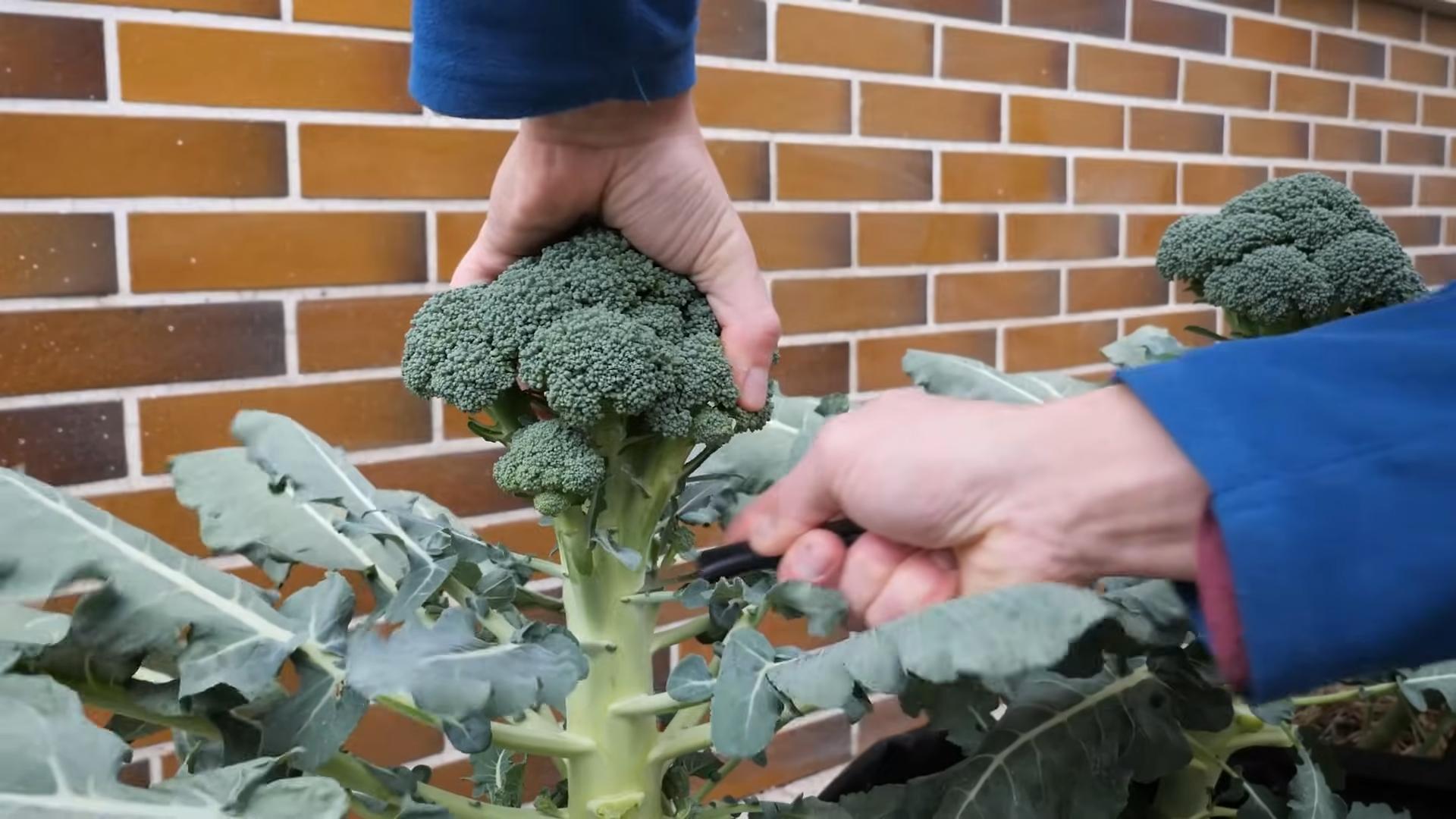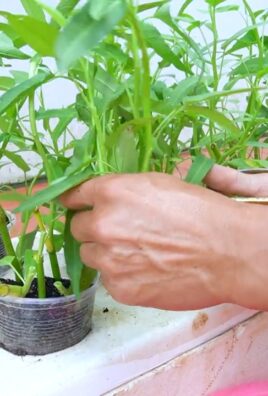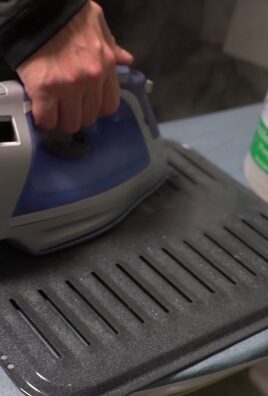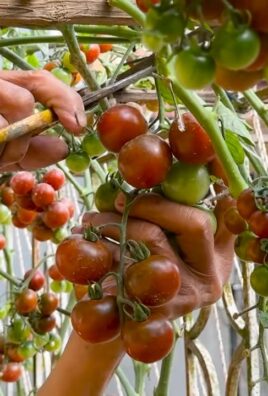Growing Broccoli in Containers might seem like a challenge reserved for seasoned gardeners with sprawling plots, but I’m here to tell you it’s totally achievable, even if your “garden” is just a sunny balcony or a small patio! Forget the image of endless rows of broccoli stretching to the horizon; we’re bringing the farm-to-table experience right to your doorstep, one container at a time.
Broccoli, a nutritional powerhouse packed with vitamins and antioxidants, has a rich history dating back to ancient Rome. For centuries, it’s been a staple in diets worldwide, prized for its health benefits and versatility in the kitchen. But let’s be honest, buying broccoli from the store can sometimes feel… disconnected. You don’t know where it came from, how it was grown, or how long it’s been sitting on the shelf. That’s where the magic of DIY comes in!
In this article, I’m going to share my favorite tips and tricks for successfully growing broccoli in containers. I’ll guide you through everything from choosing the right container and soil to providing the perfect amount of sunlight and water. Imagine the satisfaction of harvesting your own fresh, organic broccoli, knowing exactly what went into it. Plus, it’s a fantastic way to reduce your carbon footprint and connect with nature, even in the heart of the city. So, grab your gardening gloves, and let’s get started on this exciting journey of growing your own delicious and healthy broccoli!

Growing Broccoli in Containers: A Beginner’s Guide
Okay, so you want to grow broccoli, but you don’t have a sprawling garden? No problem! Growing broccoli in containers is totally doable, and I’m here to walk you through it. It’s surprisingly rewarding to harvest your own fresh broccoli heads, even from a small balcony or patio. Let’s get started!
Choosing the Right Container and Soil
This is a crucial first step. Broccoli needs space to grow, so don’t skimp on the container size.
* Container Size: Aim for at least a 5-gallon container, but a 10-gallon one is even better. The bigger, the better, really. This gives the roots plenty of room to spread out and access nutrients. A wider container is preferable to a taller, narrower one.
* Material: Plastic, terracotta, or even fabric grow bags will work. Just make sure your chosen container has good drainage holes. Broccoli hates sitting in soggy soil.
* Soil: Don’t even think about using garden soil straight from the ground. It’s usually too heavy and doesn’t drain well enough for container gardening. Instead, opt for a high-quality potting mix. Look for a mix that’s specifically formulated for vegetables, or create your own by combining equal parts of:
* Peat moss (or coconut coir for a more sustainable option)
* Compost (provides nutrients!)
* Perlite or vermiculite (for drainage and aeration)
Selecting Your Broccoli Variety
Not all broccoli varieties are created equal, especially when it comes to container gardening. Some are better suited for smaller spaces than others.
* Consider Size: Look for compact or dwarf varieties. These tend to be smaller and more manageable in containers. Some good options include:
* ‘Waltham 29’: A classic, reliable variety.
* ‘Premium Crop’: Known for its large, tight heads.
* ‘Green Magic’: A fast-maturing variety.
* ‘De Cicco’: Produces a main head followed by smaller side shoots.
* Days to Maturity: Pay attention to the “days to maturity” listed on the seed packet or plant label. This tells you how long it will take for the broccoli to be ready for harvest after planting. Choose a variety that fits your growing season.
Planting Your Broccoli
You can start broccoli from seed or purchase transplants from a nursery. I personally prefer transplants because they give you a head start, but starting from seed is definitely cheaper.
Starting from Seed (Optional)
1. Start Indoors: Begin seeds indoors about 6-8 weeks before the last expected frost in your area.
2. Seed Starting Mix: Use a seed starting mix, which is finer and lighter than potting mix.
3. Planting Depth: Sow seeds about ¼ inch deep in small pots or seed trays.
4. Keep Moist: Keep the soil consistently moist but not soggy.
5. Provide Light: Place the seedlings under grow lights or in a very sunny window. They need at least 6 hours of light per day.
6. Harden Off: Before transplanting outdoors, gradually acclimate the seedlings to outdoor conditions over a period of 7-10 days. This process is called “hardening off.” Start by placing them outside for a few hours each day, gradually increasing the amount of time they spend outdoors.
Transplanting Broccoli
1. Prepare the Container: Fill your chosen container with the potting mix, leaving a few inches of space at the top.
2. Dig a Hole: Dig a hole in the center of the container that’s large enough to accommodate the root ball of the transplant.
3. Gently Remove the Transplant: Carefully remove the broccoli transplant from its nursery pot. Gently loosen the roots if they are tightly bound.
4. Plant the Transplant: Place the transplant in the hole and backfill with potting mix. Make sure the top of the root ball is level with the soil surface.
5. Water Thoroughly: Water the transplant thoroughly after planting.
Caring for Your Broccoli Plants
Broccoli needs consistent care to thrive in containers.
* Sunlight: Broccoli needs at least 6 hours of direct sunlight per day. Place your container in the sunniest spot you can find.
* Watering: Water regularly, especially during hot, dry weather. The soil should be consistently moist but not waterlogged. Check the soil moisture by sticking your finger into the soil. If the top inch feels dry, it’s time to water.
* Fertilizing: Broccoli is a heavy feeder, meaning it needs a lot of nutrients. Fertilize every 2-3 weeks with a balanced liquid fertilizer, following the instructions on the label. You can also use a slow-release fertilizer at planting time.
* Mulching: Add a layer of mulch around the base of the plant to help retain moisture, suppress weeds, and regulate soil temperature. Straw, shredded leaves, or wood chips work well.
* Pest Control: Keep an eye out for common broccoli pests, such as cabbage worms, aphids, and flea beetles.
* Cabbage Worms: These green caterpillars can quickly devour broccoli leaves. Handpick them off the plants or use a biological insecticide like Bacillus thuringiensis (Bt).
* Aphids: These tiny insects suck sap from the plants, causing them to weaken. Spray them off with a strong stream of water or use insecticidal soap.
* Flea Beetles: These small, jumping beetles can create small holes in the leaves. Cover the plants with row covers to prevent them from reaching the plants.
* Weed Control: Remove any weeds that pop up in the container. Weeds compete with the broccoli for nutrients and water.
Harvesting Your Broccoli
Harvest time is the most exciting part!
1. Timing is Key: Harvest the broccoli head when the buds are tight and firm, before they start to open and flower. The head should be a deep green color.
2. Use a Sharp Knife: Cut the main head off the plant with a sharp knife, about 5-6 inches below the head.
3. Encourage Side Shoots: After harvesting the main head, the plant will often produce smaller side shoots. Continue to water and fertilize the plant to encourage these side shoots to develop.
4. Harvest Side Shoots: Harvest the side shoots when they are the desired size.
Troubleshooting
Even with the best care, you might encounter some problems. Here are a few common issues and how to address them:
* Yellowing Leaves: This could be a sign of nutrient deficiency, overwatering, or underwatering. Check the soil moisture and fertilize if necessary.
* Small Heads: This could be due to insufficient sunlight, poor soil, or lack of fertilizer. Make sure the plant is getting enough sunlight, use a high-quality potting mix, and fertilize regularly.
* Bolting (Flowering): Broccoli can bolt (flower) if it’s exposed to hot weather. Try to plant broccoli in the spring or fall to avoid the hottest months.
Tips for Success
Here are a few extra tips to help you succeed with container broccoli:
* Choose the Right Location: As mentioned before, sunlight is crucial. Pick a spot that gets at least 6 hours of direct sun.
* Rotate Your Crops: If you grow broccoli in the same container year after year, the soil can become depleted of nutrients. Rotate your crops by planting different vegetables in the container each year.
* Don’t Overcrowd: Plant only one broccoli plant per 5-10 gallon container. Overcrowding can lead to smaller heads and increased disease risk.
* Water Deeply: When you water, water deeply so that the entire root ball is moistened.
* Be Patient: Broccoli takes time to grow. Don’t get discouraged if you don’t see results immediately. With proper care, you’ll be harvesting your own delicious broccoli in no time!
Growing broccoli in containers is a fun and rewarding experience. With a little bit of planning and effort, you can enjoy fresh, homegrown broccoli even if you don’t have a traditional garden. Happy gardening!

Conclusion
So, there you have it! Growing broccoli in containers isn’t just a possibility; it’s a rewarding and surprisingly simple way to enjoy fresh, homegrown goodness, even if you’re short on space. We’ve walked through the essential steps, from selecting the right container and soil to nurturing your broccoli plants to a bountiful harvest. But why is this DIY trick a must-try?
First and foremost, it puts you in control. You know exactly what goes into your broccoli, avoiding the pesticides and herbicides that can sometimes be found in commercially grown produce. Secondly, it’s incredibly satisfying. There’s a unique joy in watching a tiny seedling transform into a vibrant, edible plant, knowing you played a direct role in its growth. And finally, it’s convenient! Having fresh broccoli just steps away from your kitchen door is a game-changer for healthy eating.
But don’t stop there! Experiment with different broccoli varieties. ‘Waltham 29’ is a classic choice, but consider trying ‘De Cicco’ for smaller heads and more side shoots, or ‘Purple Sprouting’ for a beautiful and nutritious addition to your garden. You can also companion plant with herbs like rosemary or thyme to deter pests naturally. Consider adding marigolds around the base of your container to further ward off unwanted insects.
Another variation to explore is succession planting. By starting new seeds every few weeks, you can extend your broccoli harvest throughout the growing season. This ensures a continuous supply of fresh broccoli for your meals.
Don’t be afraid to get your hands dirty and embrace the learning process. Gardening is all about experimentation and adapting to your specific environment. Pay close attention to your plants, observe their growth patterns, and adjust your care accordingly.
We wholeheartedly encourage you to give growing broccoli in containers a try. It’s an accessible and fulfilling project that will reward you with delicious, healthy produce. And most importantly, we want to hear about your experience! Share your successes, your challenges, and any tips you discover along the way in the comments below. Let’s build a community of container broccoli growers and learn from each other. Your insights could be invaluable to someone just starting out. So, grab your seeds, your soil, and your containers, and get ready to embark on a rewarding gardening adventure. Happy growing!
Frequently Asked Questions (FAQ)
What size container do I really need for growing broccoli?
The ideal container size for growing broccoli is at least 12 inches in diameter and 12 inches deep, but bigger is generally better. A 5-gallon bucket or a large planter pot works well. The larger the container, the more room the roots have to grow, which translates to a healthier and more productive plant. If you’re planning on growing multiple broccoli plants in one container, opt for an even larger container, such as a half-barrel planter. Insufficient space can lead to stunted growth and smaller broccoli heads.
How often should I water my container broccoli?
Watering frequency depends on several factors, including the weather, the type of soil you’re using, and the size of your container. Generally, you should water your broccoli plants deeply whenever the top inch of soil feels dry to the touch. During hot, dry weather, this may mean watering daily, while in cooler, wetter weather, you may only need to water every few days. Avoid overwatering, as this can lead to root rot. Ensure your container has adequate drainage holes to prevent water from pooling at the bottom. A good rule of thumb is to water until you see water draining from the bottom of the container.
What kind of fertilizer is best for container broccoli?
Broccoli is a heavy feeder, meaning it requires a lot of nutrients to grow properly. A balanced fertilizer with an NPK ratio (nitrogen, phosphorus, potassium) of 10-10-10 or 14-14-14 is a good starting point. You can also use a fertilizer specifically formulated for vegetables. Apply fertilizer according to the package directions, usually every 2-3 weeks. Alternatively, you can use organic fertilizers such as compost tea or fish emulsion. These provide a slow-release source of nutrients and are beneficial for soil health. Be sure to monitor your plants for signs of nutrient deficiencies, such as yellowing leaves, and adjust your fertilization accordingly.
How do I deal with pests on my container broccoli?
Pests can be a challenge when growing broccoli, but there are several ways to manage them organically. Common pests include aphids, cabbage worms, and flea beetles. Regularly inspect your plants for signs of infestation. Handpicking pests off the plants is an effective method for small infestations. You can also use insecticidal soap or neem oil to control pests. These are natural and relatively safe options. Covering your plants with row covers can also prevent pests from reaching them in the first place. Companion planting with herbs like rosemary, thyme, or sage can also help deter pests.
When is the right time to harvest my container broccoli?
The right time to harvest broccoli is when the head is firm and the florets are tightly closed. If the florets start to open and turn yellow, it’s a sign that the broccoli is past its prime. Use a sharp knife to cut the main head off the plant, leaving several inches of stem. This will encourage the plant to produce side shoots, which you can harvest later. Harvest in the morning when the broccoli is cool and crisp.
Can I grow broccoli in containers indoors?
While it’s possible to grow broccoli indoors, it can be challenging. Broccoli requires a lot of sunlight, at least 6-8 hours per day. If you don’t have a sunny window, you’ll need to supplement with grow lights. You’ll also need to ensure good air circulation to prevent fungal diseases. Indoor growing can be more susceptible to pests, so regular monitoring is crucial. Overall, growing broccoli in containers outdoors is generally easier and more successful, but with the right conditions, indoor growing is possible.
What are some common problems I might encounter when growing broccoli in containers, and how do I fix them?
Several problems can arise when growing broccoli in containers. Yellowing leaves can indicate nutrient deficiencies, overwatering, or underwatering. Adjust your watering and fertilization accordingly. Stunted growth can be caused by insufficient sunlight, inadequate container size, or poor soil quality. Ensure your plants are getting enough sunlight, transplant them into a larger container if necessary, and use a high-quality potting mix. Pests can also be a problem, as mentioned earlier. Addressing these issues promptly will help ensure a healthy and productive broccoli harvest.
How do I prevent my broccoli from bolting (going to seed)?
Bolting, or premature flowering, can occur when broccoli plants are exposed to stress, such as extreme heat or inconsistent watering. To prevent bolting, choose bolt-resistant varieties, provide consistent watering, and protect your plants from extreme temperatures. Mulching around the base of the plants can help retain moisture and regulate soil temperature. If you live in a hot climate, consider providing shade during the hottest part of the day.
Can I reuse the soil from my container after harvesting broccoli?
While you can reuse the soil, it’s best to amend it with fresh compost or other organic matter to replenish nutrients. Broccoli is a heavy feeder, so the soil will likely be depleted of nutrients after a harvest. Adding compost will also improve soil structure and drainage. Alternatively, you can replace the soil entirely. Avoid planting broccoli in the same container year after year to prevent the buildup of soilborne diseases.




Leave a Comment